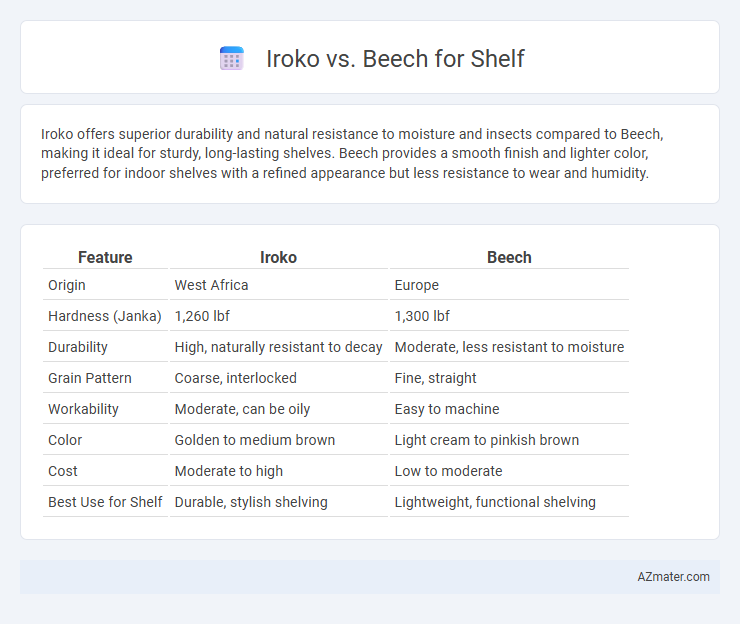Iroko offers superior durability and natural resistance to moisture and insects compared to Beech, making it ideal for sturdy, long-lasting shelves. Beech provides a smooth finish and lighter color, preferred for indoor shelves with a refined appearance but less resistance to wear and humidity.
Table of Comparison
| Feature | Iroko | Beech |
|---|---|---|
| Origin | West Africa | Europe |
| Hardness (Janka) | 1,260 lbf | 1,300 lbf |
| Durability | High, naturally resistant to decay | Moderate, less resistant to moisture |
| Grain Pattern | Coarse, interlocked | Fine, straight |
| Workability | Moderate, can be oily | Easy to machine |
| Color | Golden to medium brown | Light cream to pinkish brown |
| Cost | Moderate to high | Low to moderate |
| Best Use for Shelf | Durable, stylish shelving | Lightweight, functional shelving |
Introduction to Iroko and Beech Wood
Iroko wood, known for its rich golden to medium brown color, offers exceptional durability and natural resistance to decay and insects, making it a popular choice for high-quality shelving. Beech wood features a pale cream color with fine, even texture and is prized for its hardness and smooth finish, ideal for indoor furniture and shelves requiring a refined appearance. Both woods provide strong structural support, but Iroko's moisture resistance gives it an advantage in more demanding environments.
Origin and Availability of Iroko vs Beech
Iroko wood originates primarily from West Africa, particularly Nigeria and Cameroon, and is known for its natural durability and resistance to decay, making it a preferred choice in tropical climates. Beech wood, predominantly sourced from Europe, especially Germany and France, is widely available and valued for its fine, uniform texture and workability in cabinetry and shelving. Availability of Iroko can be limited outside Africa due to export restrictions, whereas Beech remains more accessible and affordable globally due to sustainable forestry practices in Europe.
Physical Properties: Strength and Durability
Iroko wood offers exceptional strength and high resistance to wear, making it ideal for durable shelving that supports heavy loads without warping. Beech wood has a fine, tight grain with good hardness, providing solid strength but is less resistant to moisture and decay compared to Iroko. The superior durability of Iroko, combined with its natural oils that enhance water resistance, often makes it the preferred choice for long-lasting shelves in environments prone to humidity.
Appearance and Grain Patterns
Iroko wood showcases a rich golden to medium brown hue with a straight grain pattern that often features interlocking grains, creating a textured and somewhat coarse surface ideal for distinctive shelves. Beech wood displays a pale cream to light reddish-brown coloration with a fine, even grain and smooth texture, providing a clean and uniform appearance perfect for modern shelving designs. The contrasting grain complexity between Iroko's bold, prominent patterns and Beech's subtle, consistent look offers diverse aesthetic options depending on the desired shelf style.
Workability and Ease of Machining
Iroko is a hardwood known for its excellent workability, offering easy cutting, shaping, and sanding due to its interlocked grain and moderate density, making it ideal for shelves requiring precise detailing. Beech also excels in machinability with a smooth texture and consistent grain, allowing for effortless drilling and planing, which results in clean edges and a fine finish. Both woods provide reliable ease of machining, but Iroko's natural oils can slightly affect glue adhesion, whereas Beech's hardwood density ensures strong joints and stable assembly.
Resistance to Wear, Decay, and Pests
Iroko wood exhibits exceptional resistance to wear, decay, and pests due to its dense, oily grain structure, making it ideal for long-lasting shelves in high-moisture environments. Beech wood, while hard and durable, lacks the natural oils found in iroko, rendering it more susceptible to fungal decay and insect infestation over time. Choosing iroko ensures superior durability and minimal maintenance for shelves exposed to heavy use or varying indoor conditions.
Weight and Load-Bearing Capacity
Iroko wood, with its density averaging around 650-850 kg/m3, offers a higher load-bearing capacity compared to Beech, which has a density of approximately 720 kg/m3. The greater weight of Iroko contributes to its superior strength and durability, making it ideal for heavy-duty shelving applications. Beech, while slightly lighter, provides a good balance of stiffness and toughness but may not support as much weight as Iroko under heavy loads.
Cost Comparison: Iroko vs Beech
Iroko wood typically costs more than beech due to its durability and resistance to moisture, making it a premium choice for shelves in humid environments. Beech, being a more abundant and softer hardwood, offers a budget-friendly option with moderate strength suitable for standard shelving needs. When comparing cost efficiency, beech provides better initial affordability, while iroko offers long-term value through enhanced longevity and reduced maintenance.
Environmental Impact and Sustainability
Iroko wood, sourced primarily from West African tropical forests, is valued for its durability but faces scrutiny due to deforestation concerns and slower growth rates compared to Beech, which is native to Europe and known for faster regeneration and sustainable forestry practices. Beech wood, often harvested from sustainably managed forests certified by organizations like FSC, offers a lower carbon footprint and reduced environmental impact due to its widespread availability and efficient growth cycle. Choosing Beech for shelves supports better sustainability by minimizing habitat disruption and promoting responsible timber sourcing, whereas Iroko's environmental cost depends heavily on the certification and region of harvest.
Final Recommendation: Choosing Between Iroko and Beech for Shelving
Iroko offers superior durability and natural resistance to moisture and decay, making it ideal for heavy-duty shelves in humid environments, while beech provides a smooth finish and lighter color that suits indoor, decorative shelving with moderate load requirements. Consider the environmental conditions and aesthetic preferences: Iroko withstands wear and outdoor exposure better, whereas beech enhances elegance with its fine grain and ease of staining. For long-lasting, robust shelving, choose Iroko, but for refined, indoor applications with a classic appearance, beech is preferable.

Infographic: Iroko vs Beech for Shelf
 azmater.com
azmater.com